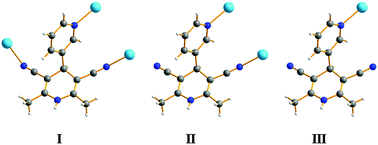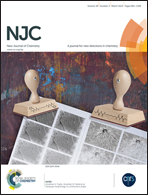Structural diversity in the self-assembly of Ag(i) complexes containing 2,6-dimethyl-3,5-dicyano-4-(3-pyridyl)-1,4-dihydropyridine†
Abstract
A series of silver(I) complexes of the type [Ag(L)2][PF6], 1, {[Ag(L)2][PF6]}∞, 2, {[Ag(L)(CH3CN)][BF4]}∞, 3, {[Ag(L)(CH3CN)][CF3SO3]}∞, 4, and {[Ag2(L)2(ClO4)][ClO4]}∞, 5 [L = 2,6-dimethyl-3,5-dicyano-4-(3-pyridyl)-1,4-dihydropyridine] have been prepared by reactions of various Ag(I) salts with L in different solvent systems. All the complexes have been structurally characterized by X-ray crystallography confirming that complex 1 is a 0-D molecular complex, while complexes 2–5 are one-dimensional coordination polymeric chains. The L ligands in complex 1 act as new unidentate ligands to bond Ag(I) ions, while the L ligands in complexes 2–5 act as bi- and tri-dentate ligands to bridge Ag(I) ions. The anions PF6−, BF4− and CF3SO3− in complexes 1–4 are not coordinated to the Ag(I) atoms while the ClO4− anions in complex 5 are coordinated to the metal centers through one of the four oxygen atoms. The resulting structural types of complexes 1–5 are affected by factors such as counteranions and solvents, the anions in complexes 1–5 play important roles in linking cationic chains or layers to form 3-D supramolecular structures.


 Please wait while we load your content...
Please wait while we load your content...